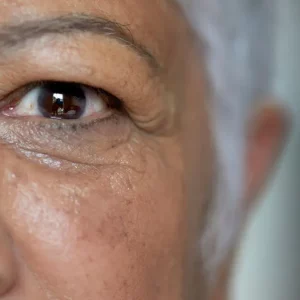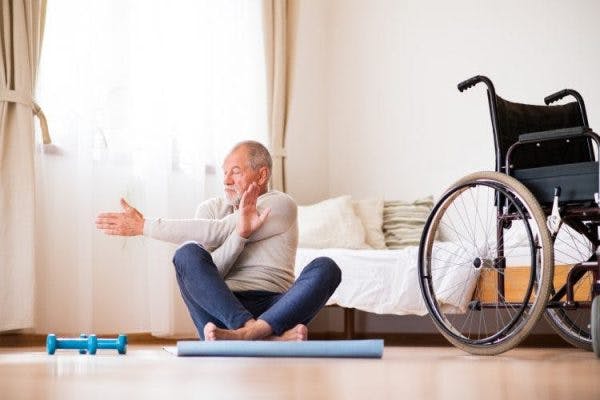Constraint-induced movement therapy (CIMT) is a technique focused on enhancing the use of affected limbs following a neurological injury, such as a stroke or cerebral palsy. Practicing constraint-induced movement therapy exercises consistently can boost recovery among individuals with hemiparesis or other conditions where only one side of the body is affected.
When movement on one side of the body is weakened due to a neurological injury, individuals may find it easier to rely on their unaffected side. However, continuous disuse of an affected limb may result in even further impairments (learned non-use). Therefore, to improve functional use of the affected extremity, therapists may recommend participating in constraint-induced movement therapy.
This article will provide an overview of how constraint-induced movement therapy can be beneficial for recovering movement after neurological injury. Additionally, details regarding the effectiveness of CIMT and potential drawbacks will also be included. Use the links below to jump directly to any section.
- What is constraint-induced movement therapy?
- Why is CIMT effective?
- Constraint-induced movement therapy exercises
- Evidence supporting CIMT
- Drawbacks of CIMT
What is Constraint-Induced Movement Therapy?
Constraint-induced movement therapy is an intensive therapeutic technique designed to improve functional use of affected limbs. While CIMT was originally developed to improve upper extremity use following stroke, the basic principles of the technique have now been adapted to treat other neurological conditions and assist with regaining lower extremity use, as well.
When a stroke or other neurological injury primarily affects only one side of the body, individuals often tend to rely more and more on the unaffected side of the body for their daily activities. As a result, the affected limb is gradually used less and less, until any remaining functions have deteriorated to the point that they are no longer able to be used at all. This is a phenomenon referred to as learned non-use.
Constraint-induced movement therapy can be an excellent treatment option for combatting learned-nonuse. The treatment involves three main components:
- Restraining use of the unaffected side. This can involve wearing a thick glove or simply concentrating on using only the affected extremity.
- Intensive, repetitive task practice with affected side. Using the affected extremity to practice targeted skills is essential for improving functional use, as repetitive practice of constraint-induced movement therapy exercises promotes adaptive brain rewiring.
- Encouraging carryover of skills to daily life. Promoting continued intentional use of the affected extremity even outside of therapy sessions is vital for recovery.
Since CIMT focuses so intensively on using the affected limb, individuals need to have at least some motor control in their affected side in order to participate. For those who are paralyzed in one or more limbs and have lost all motor control, there are other recommended methods for recovery.
Why is CIMT Effective?
A crucial part of constraint-induced movement therapy is repetitive practice. This is because consistently performing constraint-induced movement therapy exercises stimulates the brain, promoting neuroplasticity.
Neuroplasticity is the central nervous system’s ability to reorganize itself and make adaptive changes. When the affected limb is used on a regular basis to complete specific tasks, the brain perceives a greater demand for related functions and rewires itself to complete those functions more easily.
For example, individuals focusing on regaining upper body functions could repetitively practice tasks such as grasping and turning a doorknob, wiping down tables or windows, or squeezing a sponge. Potential tasks for those working on improving lower body functions include moving from sitting to standing, walking, or going up and down stairs.
By consistently practicing tasks using constraint-induced movement therapy, individuals may gradually develop coordination, speed, strength, and more natural movement on their affected side. As these skills continue to improve, individuals can focus on more challenging tasks to continue recovering motor functions and promote further adaptive changes in the brain.
Constraint-Induced Movement Therapy Exercises
The specific tasks or exercises used during constraint-induced movement therapy vary based on the individual and their needs. Individuals focusing on regaining upper body functions will practice different exercises than those working on regaining motor control of their lower body. Additionally, constraint-induced movement therapy exercises will differ based on the individual’s skill level.
While exercises can be used to improve motor functions, many therapists emphasize practicing functional tasks as well. Below is a list of a constraint-induced movement therapy exercises and activities that therapists may recommend.
Upper Body Constraint-Induced Movement Therapy Exercises
The following exercises may be used to regain arm and hand functions:
- Opening and closing the hand
- Touching each finger to the thumb
- Bending and extending the elbow
- Reaching the arm across the body and back out to the side
- Lifting the arm above the head and back down
Functional tasks that may be recommended include:
- Using a fork to eat
- Reaching into an overhead cupboard
- Putting on a shirt
- Grasping various items
As individuals improve, they can gradually practice more challenging tasks or use their affected arm more frequently. Consistently practicing these and other tasks involving the arm and hand can promote improvements through neuroplasticity.
Lower Body Constraint-Induced Movement Therapy Exercises
Here are some potential exercises that may be recommended for those working on regaining lower body functions:
- Marching (while seated or standing)
- Tapping the toes up and down
- Extending and flexing the knee while seated
- Moving from sitting to standing
Other activities that can help individuals recover leg functions include:
- Transferring from lying down to sitting
- Walking on different surfaces (indoors and outdoors)
- Getting into and out of a car
- Using a stationary bike
While there are endless constraint-induced movement therapy exercises and activities that may be used to regain both upper and lower body motor skills, the examples listed here may be a good starting point. Individuals interested in participating in CIMT should talk with a physical or occupational therapist to learn more about what specific constraint-induced movement therapy exercises would be best for them.
Evidence Supporting Constraint-Induced Movement Therapy
There is a significant amount of research regarding the use of CIMT to improve arm and hand functions, and a growing number of articles regarding its effectiveness in promoting leg functions. In fact, one article even reported that CIMT and modified CIMT programs are considered “the most effective treatment regimens” to improve motor functions in the upper extremity.
Listed below are the findings of a few recent articles regarding the effectiveness of CIMT:
- A 2022 systematic review and meta-analysis found that stroke survivors participating in CIMT experienced greater independence and better functional use of the arm during daily self-care tasks than those receiving conventional therapy treatment.
- A 2021 systematic review and meta-analysis examining the use of CIMT for improving leg functions revealed that although CIMT improved numerous skills, like motor function, mobility, balance, and gait speed, its benefits were similar to conventional therapy in all areas except for quality of life.
- A 2021 randomized clinical trial found that a modified CIMT program applied for 1 hour per day, 3 days per week resulted in improved upper extremity motor functions and quality of life in chronic stroke survivors.
There are many other studies citing the benefits of CIMT, especially for stroke survivors. While not as prevalent, there is also some research regarding the effectiveness of CIMT for those with cerebral palsy, traumatic brain injury, and other neurological conditions.
Drawbacks of CIMT
While constraint-induced movement therapy can be a very effective method for improving motor functions after a neurological injury, it is not recommended for everyone. Some drawbacks of CIMT include:
- Highly intensive. Traditional CIMT protocols involve forced use of the affected extremity for up to 90% of waking hours for two weeks. While this does allow for consistent and repetitive practice of tasks using the affected extremity, it may be a challenging and frustrating experience.
- One-sided focus. Consistently practicing constraint-induced movement therapy exercises and activities using only the affected side of the body may limit improvements in the ability to use both sides of the body together cooperatively. Other rehabilitative techniques may focus more on coordinating both sides of the body to work together.
- Requires persistence and motivation. While some portions of CIMT are completed in a clinical setting, there is a great emphasis on continuing use the affected extremity functionally at home as well. If individuals “cheat” by using the unaffected extremity to complete most tasks at home, they may not get the full benefits of the treatment.
- Specific to a certain population. Although CIMT treatment can be very effective for individuals with one-sided motor deficits, it is not designed to be used with people who experience paralysis or weakness in both arms or both legs.
Constraint-induced movement therapy is not appropriate for everyone. Individuals who lack the motivation or stamina to participate in the full CIMT protocol may benefit from a less-intensive modified CIMT program. Interested individuals should consider talking with their physical or occupational therapist to determine whether it could be a beneficial treatment option to boost recovery.
How to Optimize the Effects of CIMT
To maximize the effects of constraint-induced movement therapy, focus on using the affected limb as frequently and repetitively as possible. Consistent repetition of constraint-induced movement therapy exercises and activities is necessary to promote adaptive changes in the brain. Although practicing CIMT throughout the day is ideal, improvements can be made even by practicing as little as one hour per day.
While constraint-induced movement therapy is not appropriate for everyone, its basic principles can be applied to many individuals experiencing motor deficits. Through consistent practice and adaptive brain rewiring, there is always hope for recovery.

















